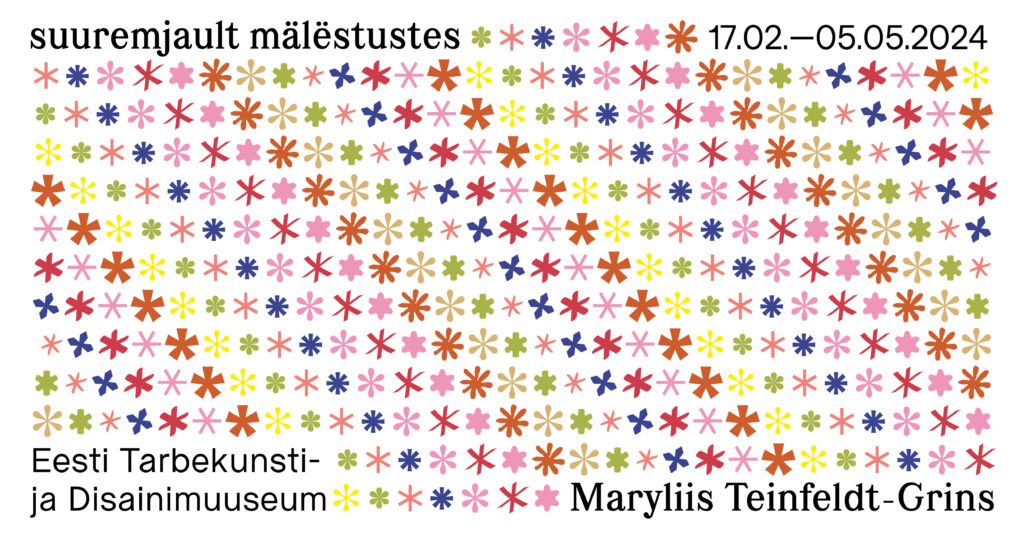Textile artist Maryliis Teinfeldt-Grins weaves landscape memories and tales of longing into her embroidery for the exhibition “Suuremjault mälëstustes”
12.2.2024
Exhibition

Starting from 17 February, the gallery of the Estonian Museum of Applied Art and Design will host the exhibition “Suuremjault mälestustes” (Mostly in Memories) by textile and installation artist Maryliis Teinfeldt-Grins. The exhibition features a meeting of poetic imagery from the artist’s debut poetry collection, “Kivi alla kükakile” (Crouching Under a Stone), and stories of longing rendered in embroidery.
The exhibition is centred around the theme of loss – originating from something that has been irrevocably lost and cannot ever be recaptured, as it begins to take shape from the moment of disappearance. This void, paradoxically, can be filled only by a sense of boundless nostalgia and longing.
“I am mainly interested in the power dynamics between humans and the natural landscape. In Estonia, five different kinds of landscape can be observed. Every new position of power in society is also reflected in the landscape. I am fascinated by what humans do in landscapes, how they interact with them, what they find beautiful,” says Teinfeldt-Grins.
The exhibition showcases a series of embroidered landscape memories – places that have taken shape only in the artist’s memories. The exhibition features two works, the large-format “Military Base” and “Apartment”, that hold particular significance for the artist. Both are bird’s-eye views of Ridaküla village in Kadrina municipality.
“Most of my works are inspired by the landscapes in this area. I was particularly pleased to exhibit ‘Military Base’ at the last textile art biennial in Riga, and ‘Apartment’ is part of the ETDM’s collection. Although it has been in the museum’s collection for several years, this is the first time the museum has exhibited it in their space. I have been looking forward to this!” says Teinfeldt-Grins.
In creating these works, the artist was inspired by French historian and philosopher Michel de Certeau’s concept of récits d’espace, or spatial stories, where landscape and narrative meet. Each story is a traveller’s tale – a spatial practice that traverses different places within a landscape.
The artist says she was led to the technique of punch needle embroidery for very practical reasons. “I started my series of landscape memories, as I like to call my embroideries, during my fourth year at the Pallas University of Applied Sciences,” recalls Teinfeldt-Grins, who began writing her thesis and creating her artwork on the day that widespread Covid restrictions were imposed.
“The shops were closed, and I couldn’t work at school. I started with what I had at the moment, which seemed suitable for my goals. I really needed to express these ideas, so I decided to let them out through my embroidery. That year, during the first year of restrictions, I completed one piece. Now, with the opening of this exhibition, I am extremely pleased to note that this chapter has finally come to a close. I’ve managed to stitch all those landscape images out of my system, freeing me up to explore new creative directions,” says Teinfeldt-Grins, whose work has been attracting attention for a long time but is being exhibited for the first time this year in solo exhibitions in Tallinn.
In addition to the ETDM, Teinfeldt-Grins’ works can also be seen at Tütar Gallery in Tallinn this February.
The works exhibited at the ETDM are a selection from those presented last year at the Võru County Cultural House.
The exhibition is accompanied by an audience programme, which includes a punch needle workshop and a poetry evening on 8 March. The poetry collection “Kivi alla kükakille” is also available for sale in the museum shop.
The exhibition will remain open until 5 May 2024.
Maryliis Teinfeldt-Grins (born 1993) is an artist who tells stories of longing through landscape imagery. Her work combines embroidery, photography, tapestry, drawing and dialect poetry.
Teinfeldt-Grins graduated with a BA in Textile from Tartu Art College in 2015 and furthered her education at the Art Academy of Latvia’s Department of Textile Art. She continued her studies in the Contemporary Art programme at the Estonian Academy of Arts (MA, 2022). She has been recognised with several Estonian art awards: the Eduard Wiiralt Scholarship (2019) and the Adamson-Eric Scholarship (2021). She has also received literary awards, including being a laureate of the Prima Vista literary festival’s First Step Award and the main prize winner of the Hendrik Adamson dialect poetry competition. In 2019, she received the Young Textile Artist of the Year Award from the Estonian Textile Artists’ Association. Her works are part of the collection at the Estonian Museum of Applied Art and Design and have won awards in public art competitions (Pärnu Riigimaja). She is a member of the Estonian Textile Artists’ Association and the Estonian Artists’ Association.
Graphic design: Else Mare Lagerspetz
Videography: Red Serberth OÜ
Supported by: Cultural Endowment of Estonia, Tütar Gallery